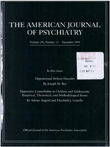Posttraumatic stress disorder after a school shooting: effects of symptom threshold selection and diagnosis by DSM-III, DSM-III-R, or proposed DSM-IV
Abstract
OBJECTIVE: The purpose of the study was to investigate the effect of symptom threshold and criteria set selections on the diagnosis of posttraumatic stress disorder (PTSD) in adults and children exposed to a man-made disaster and determine how well DSM-III and its successors agree. METHOD: Data gathered in the course of a voluntary clinical screening for PTSD in 66 adults and 64 children 6 to 14 months after exposure to a school shooting were analyzed according to DSM-III, DSM- III-R, and proposed DSM-IV criteria for PTSD diagnosis and cluster endorsement using liberal (occurring at least a little of the time), moderate (occurring at least some of the time), and conservative (occurring at least much or most of the time) symptom thresholds. RESULTS: Within DSM-III, DSM-III-R, and proposed DSM-IV, selection of liberal, moderate, and conservative symptom thresholds had robust effects on rates of diagnoses; liberal thresholds allowed the greatest frequencies of diagnosis. Compared with DSM-III and proposed DSM-IV, DSM-III-R generally diagnosed the fewest cases. Agreements between DSM- III-R and proposed DSM-IV were good, while agreements between DSM-III and its successors varied for children and adults. CONCLUSIONS: Diagnostic rates and agreements were complexly influenced by interactions among threshold and revisions in symptom clusters. The present study suggests that attempts to refine PTSD classification consider specification of symptom threshold intensity and supports the view that modification of criteria sets be undertaken with caution.
Access content
To read the fulltext, please use one of the options below to sign in or purchase access.- Personal login
- Institutional Login
- Sign in via OpenAthens
- Register for access
-
Please login/register if you wish to pair your device and check access availability.
Not a subscriber?
PsychiatryOnline subscription options offer access to the DSM-5 library, books, journals, CME, and patient resources. This all-in-one virtual library provides psychiatrists and mental health professionals with key resources for diagnosis, treatment, research, and professional development.
Need more help? PsychiatryOnline Customer Service may be reached by emailing [email protected] or by calling 800-368-5777 (in the U.S.) or 703-907-7322 (outside the U.S.).



